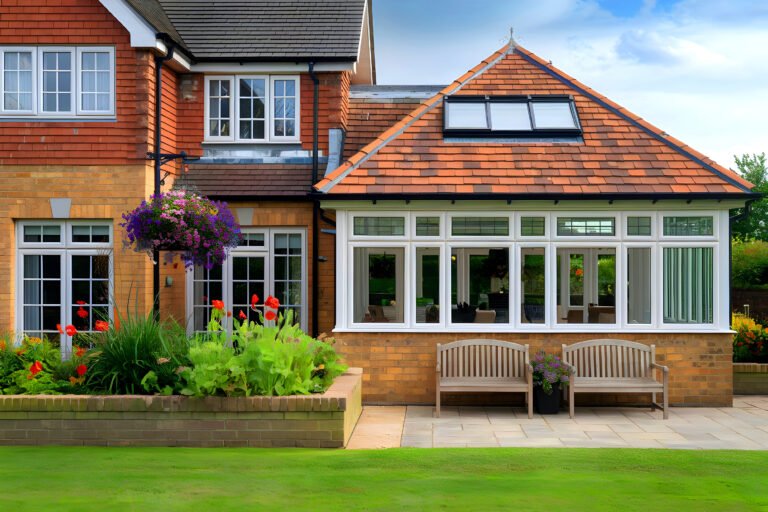In many family homes, space is at a premium. With the daily demands of parenting, school runs, meals, playtime and work, every room in the house needs to work hard—and ideally serve more than one purpose. A conservatory, when thoughtfully designed, can become one of the most versatile and useful areas of the home, especially for households with children.
Whether you need a safe play area, a space for homework, a chill-out zone for teens or a practical hub for family life, a child-friendly conservatory can offer flexibility and comfort while still feeling like an extension of your home, not an afterthought.
Making Safety the First Priority
Before turning your conservatory into a family-friendly space, it’s essential to ensure it’s safe and secure for children of all ages. Start with safety glass that meets current regulations and consider applying a window film to reduce glare and potential breakage risk. Secure blinds or window coverings should have child-safe cords or cordless mechanisms to prevent accidents.
Heating systems also need consideration—wall-mounted radiators should be cool-touch or protected, and underfloor heating is a great alternative that removes the need for bulky heaters or freestanding options. Doors should have secure locks and easy-to-use handles for grown-ups, while floor surfaces should be non-slip and easy to clean.
Designing a Practical Play Area
Younger children benefit hugely from having a dedicated space to play. A conservatory can become a safe, contained playroom that still feels connected to the rest of the house. Use low-level storage units with baskets or boxes to encourage tidiness and independence. Rugs or soft mats on tiled or wooden floors provide comfort and safety for toddlers, while bean bags and floor cushions give children space to sprawl, read or relax.
Opt for wipeable surfaces, stain-resistant fabrics and furnishings that can handle the occasional crayon or spill. Bright colours, soft lighting and wall art can turn the space into a playful, stimulating environment without overwhelming the rest of the home’s décor.
Creating Zones for Learning and Creativity
As children grow, their needs change—and the conservatory can grow with them. A dedicated homework area with a child-sized table and chair, good lighting and a supply of stationery helps encourage focus and routine. Keep distractions to a minimum in this zone and introduce small shelving or cubbies for books and folders.
For creative children, an art corner or craft station gives them a place to explore their interests without taking over the kitchen table. Add a wall-mounted whiteboard or chalkboard for sketches, notes or fun learning, and you’ve got a mini classroom that still feels part of the home.
Multi-Use Spaces for the Whole Family
In busy households, it’s often helpful to design a conservatory that serves multiple purposes. Zoning can be achieved with rugs, lighting and furniture placement—one corner might be for soft play or toys, another for quiet reading, and a third for grown-ups to enjoy a coffee in peace. The aim is to create a room that supports interaction but also allows everyone to do their own thing when needed.
Storage is key to keeping things organised. Built-in benches with lift-up lids, shelving units that double as room dividers and fold-away furniture can help you make the most of every inch. A clutter-free conservatory feels more spacious and calm, even when it’s full of family activity.
Connecting with the Garden
A child-friendly conservatory offers a natural link to the garden, making it easier to supervise outdoor play while staying warm and dry inside. Wide-opening patio or bi-fold doors let you create a seamless flow between inside and out—ideal for summer days when the kids are running in and out, or when you’re hosting a birthday party.
Add indoor plants or herbs in pots to soften the divide between home and garden, and you create an environment that helps children feel connected to nature, even when the weather doesn’t allow for outdoor play.
Keeping It Comfortable All Year Round
For a conservatory to truly work for a family, it needs to be usable year-round. Good insulation, efficient heating and appropriate window coverings all help regulate the temperature so the room doesn’t feel like a greenhouse in summer or an icebox in winter.
Thermal blinds, insulated roofing panels or even a tiled roof conversion can help stabilise the space. This ensures the conservatory remains a functional part of daily life, not just a fair-weather room. With the right setup, it can become a go-to space for everything from breakfast on a school morning to family board games on a rainy afternoon.
Making Room for Teenagers
If your children are a little older, the conservatory can offer them a semi-private space where they can study, relax or socialise. Teenagers often need somewhere slightly away from the main living room where they can play games, listen to music or unwind with friends.
Soft furnishings, a speaker system, charging points and subtle lighting can turn the space into a cool, age-appropriate retreat that still remains part of the home’s shared layout. It also gives parents peace of mind knowing where the kids are while still allowing them a sense of independence.
A Family Space That Grows With You
Perhaps the biggest advantage of a conservatory in a family home is how adaptable it can be. What starts as a toy-filled playroom can evolve into a study space, a den, or a quiet escape for reading and rest. The key is to keep the space flexible, durable and in tune with the rhythm of family life.
Choose furniture that can be moved easily, storage that can evolve with changing needs, and a layout that doesn’t box the room into one single use. That way, as your children grow, your conservatory continues to meet their needs—and yours—without needing major rework.
